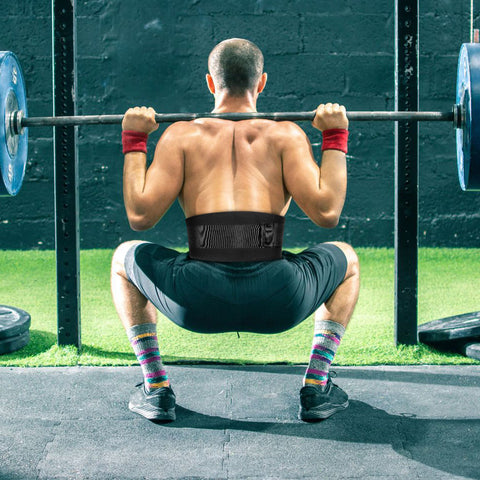How to Fix Lower Back Pain from Lifting

Many people suffer from lower back pain caused by carrying large goods. We'll talk about treating lower back pain from lifting heavy things in this article. The goal is to help people feel better by offering a variety of treatment options and preventive actions that will lessen their discomfort, encourage healing, and lessen the chance that the same problems will recur in the future.
fivalifitness.com
Understanding the Causes
There are several reasons why lifting heavy objects can cause lower back pain. Among the most typical elements are:
- Poor lifting technique: Excessive strain on the lower back muscles can result in pain when lifting large objects with improper technique, such as bending at the waist instead of the knees.
- Muscle strain: The lower back might experience muscle strain due to extended lifting, abrupt motions, and overexertion. Inflammation, soreness, and stiffness may result from this strain.
- Bad posture: Keeping bad posture when lifting something, including slouching or curving the back, can put too much strain on the lower back muscles and aggravate them.
- Weak core muscles: During lifting exercises, a weak core can undermine spinal stability and increase the risk of injury.
- Degenerative conditions: Lifting heavy objects may make persistent lower back discomfort worse. These conditions include arthritis, spinal stenosis, and herniated discs.
Finding the root cause of lifting-related lower back discomfort is crucial to ensuring appropriate care and avoiding more damage.
Immediate Steps for Relief
The following actions can be taken right away to relieve lower back pain after lifting large objects:
- Rest: Letting the lower back muscles unwind and heal by taking a brief break.
- Ice therapy: To lessen pain and inflammation, apply an ice pack to the affected area several times a day for 15 to 20 minutes at a time.
- Over-the-counter pain relief: Using over-the-counter painkillers to treat discomfort and lessen inflammation, such as acetaminophen or ibuprofen.
When a lower back injury is caused by lifting, these first steps can assist relieve acute pain and offer relief right away. It is imperative to seek professional medical examination if the discomfort continues or gets worse.
Long-Term Strategies

The following are long-term methods for preventing and treating lower back pain brought on by lifting large objects:
- Appropriate lifting methods: To lessen the strain on your lower back, get knowledgeable about and put these methods into practice. This entails bending at the knees, maintaining a straight back, and lifting with the legs as opposed to the back.
- Using back support equipment: It can assist stabilize the spine and give additional support to the lower back during lifting exercises. Examples of such equipment are weightlifting belts and back braces.
- Exercises for strengthening: Pay particular attention to strengthening the muscles that support the lower back, such as the back extensors, obliques, and abdominals. Planks, bridges, and bird dogs are a few exercises that can help strengthen and stabilize the core.
- Exercises for flexibility and mobility: To avoid muscular imbalances and tightness, keep your hamstrings, lower back muscles, and hip flexors flexible. Lunges, forward bends, and spinal twists are a few stretching exercises that can assist increase range of motion and flexibility.
- Gradual progression: To help your body adjust and strengthen, gradually increase the weight and intensity of heavy lifting exercises over time.
- Ergonomic considerations: Be mindful of ergonomics at home and at work. When lifting, wear appropriate equipment, keep your spine neutral whether sitting or standing, and make sure your workspace is organized to encourage good body mechanics.
- Frequent physical activity and exercise: Exercise on a regular basis to keep your total strength, flexibility, and endurance. Engaging in exercises such as yoga, swimming, and walking can help maintain the health of your back.
- Weight control: To lessen the tension on your lower back, keep your weight at a healthy level. Being overweight can exacerbate back discomfort by placing extra strain on the spine.
- Rest and recuperation: After engaging in activities involving heavy lifting, give yourself adequate time to rest and recuperate. Take care of your body by not overdoing it.
It's crucial to remember that these tactics may change based on unique circumstances, so speaking with a physical therapist or other healthcare provider can offer tailored advice and suggestions for your particular case.
fivalifitness.com
*Disclaimer
The information provided in articles written by Fivali is intended for educational and reference purposes only. The content on this website (www.fivalifitness.com) is not intended to diagnose, treat, cure, or prevent any disease. We do not recommend self-diagnosis or self-treatment based on the information provided in our articles. Always consult a qualified healthcare professional if you have any concerns about your health or well-being.
If you are experiencing any symptoms or discomfort, we strongly encourage you to seek medical attention from a qualified healthcare professional. Only a licensed healthcare practitioner can provide an accurate diagnosis and an appropriate treatment plan tailored to your individual needs.
0 comments


